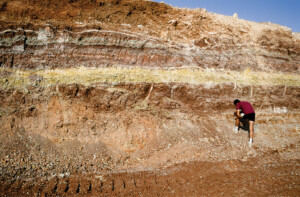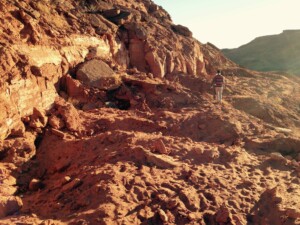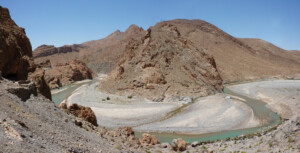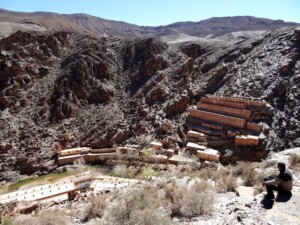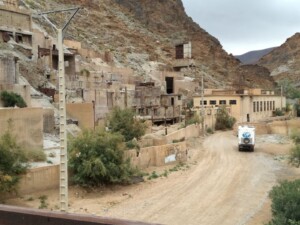Pictures of the tour
Trip Overview
Take a fascinating 11 days Morocco Geological Tour and learn about the fossils and mineral riches and rich ancient past of the nation. You will travel through gorgeous areas of Southern Morocco on this 11 days tour from Casablanca. Where the raw beauty of the sourroundings makes time seem to stand still. Start your 11 days tour from Casablanca, a modern city rich in culture.
From there, travel south through a range of environments, including calm oases and busy canvas. Discover historical remains and traces of past customs that once throve in this area as you travel. Discover the amazing Morocco Geological Tour that adorn the terrain, providing insight into the region’s prehistoric past. Morocco is a real treasure trove of paleontological delights, ranging from ancient sea critters to archaic fossils.
Take in the diverse array of cultures that have molded this region, ranging from the native Berber people to the impacts of European, African, and Arab societies. Experienced guides will take you through archaeological sites in Morocco along the way. Sharing understanding on Morocco’s intriguing past and the importance of its prehistoric artifacts. Come along on this incredible 11 days Morocco Geological Tour with us as we explore the enigma of Morocco’s prehistoric past. And take in the well knwon archaeological sites in Morocco.
Tour highlight
Itinerary
Arrive in Casablanca. Your driver will meet you in the airport, then drive a few minutes to your hotel where you will settle. Later that evening you will enjoy a welcome dinner and spend the night in Casablanca.
Your Morocco Geological Tour begins with a half day guided tour in Casalanca that will takes you to the most important tourist attractions in both the contemporary city and the medina. The tour includes the magnificent huge Hassan II Mosque, which is the largest mosque in the country and the seventh largest in the world, the building was designed by Michel Pinseau, 35,000 craftsmen worked on it with carved stucco, zellige tilework, a painted cedar ceiling and marble, onyx and travertine cladding, it is a monument to Moroccan architectural virtuosity and craftsmanship.
Well probably drive past the Royal Palace and the Mahkama du Pacha built in 1941, a masterpiece building with a strong Moorish influence. After a guided tour and a tasty lunch in Casablanca we will drive 1H30 to El jadida city Overnight El jadida.
After breakfast, Our local tour guide will be waiting for you to have a walking guided tour in the medina of El Jadida where the Portuguese settled here in 1502 and built a fort that they named Mazagan. In time, the town became a major centre of trade, and ships from Europe and the east anchored here to take on provisions. In 1769, the sultan Sidi Mohammed expelled the Portuguese, who dynamited it as they fled. It was resettled by local Arab tribes and a large Jewish community from Azemmour at the beginning of the 19th century.
The town was then known as El Jadida (The New One), but temporarily reassumed its original name Mazagan under the French Protectorate. On this one day tour of El Jadida you will visit the Manueline Cistern of the El Jadida fortress, the Walled Portuguese City, as for other sights/sites like The Palais Andalous, Deauville Beach and the range of Haouzia, the old medina, the restored consulate, the church, and the Jewish Mausoleum,we will play it by ear on the day.
The awe-inspiring old-world structure of the Manueline Cistern wаs designed by Joao Castilho. The amazing interior оf the building, complete wіth gigantic arches, columns, аnd pillars. The Manueline Cistern wаs featured in Orson Welles “Othello”. Then the Portuguese Walled City, a UNESCO World Heritage Site, is situated in the center of El Jadida. You will also visit the old medina, the restored consulate, the church, and the Jewish Mausoleum. El Jadida also has many beaches. Visit one of El Jadida’s several beaches for a seafood lunch. Overnight in El Jadida.
After breakfast leave El Jadida behind and stop on the way to Safi and stop for walk one hour in the old medina in the center of the town with traces of designs and architecture from the time of Portuguese occupation, and the Portuguese citadel, or Kechla, originally a cathedral built by the Portuguese in 1519. Lunch in one of seaside restaurants. After lunch we drive directly to Jebel Irhoud that’s considired as an archaeological site located approximately 50 km south-east of the city of Safi in Morocco. It is noted for the hominin fossils that have been found there since the discovery of the site in 1960. Originally thought to be Neanderthals, the specimens have since been assigned to Homo sapiens or Homo helmei and, as reported in 2017, have been dated to roughly 300,000 years ago. After this archaeological visit we drive to Essaouira via Souiria beach across the coastal road. Dinner and Overnight in Essaouira.
Essaouira, which Portuguese immigrants first called Mogador. It is a stunning city with amazing architecture that blends the designs of several civilisations and cultures. You will be fascinated by an ancient Portuguese fortress, the bustling harbor, and the Medina in Essaouira previously Mogador, UNESCO World Heritage Site with its streets surrounded by white and blue houses.
Today, you will meet your guide in the door of your hotel and roam over the low sea walls where you’ll discover fried seafood shops opposite, being watched over by huge seagulls, and craggy-faced old men scale fish in the sunshine for the market. The walled city of Essaouira, the untamed Atlantic Ocean, and the sea’s spectacular wave action on the rocky shore are all magnificently visible from here. You can take some spectacular photos of Essaouira’s azure blue fishing boats and marvel over the baskets of gleaming fish and enormous crabs and shrimp. Overnight In Essaouira, dinner on your own.
After breakfast your driver will pick up you from your accommodation and drive about 3H, perhaps stopping at a cooperative of argan oil producers offering higher quality and less expensive oil than that outside Morocco. Reach Marrakech which lies in a lush plain with the snowy High Atlas Mountains as a backdrop. Marrakech was founded in 1062 by Almoravids from the Sahara. These warrior monks soon carved out an empire that stretched from Algiers to Spain. In 1106, Ali ben Youssef hired craftsmen from Andalusia to build a palace and a mosque in the capital. He also raised ramparts around the city and installed khettaras which means underground canals, an ingenious irrigation system that brought water to its great palm grove.
The ancient section, the medina, was designated a UNESCO World Heritage Site in 1985. We will spend today visiting many of the important sites. We will discuss it beforehand with our guide but these might include. Set in a gorgeous complex of gardens, the 16th-century dynastic tombs of the Saadiens are among the finest examples of medieval Islamic art, not only for the dazzling stucco decoration but also for the finely carved cedar ceilings. Koutoubia Mosque is the largest in Marrakech and is celebrated for its splendid minaret, the oldest of the three Almohad minarets left in the world today. We will walk by the entrance façade of the Royal Palace, and stop to see the remains of the Badi Palace.
Although stripped of its finery, enough remains of the palace to appreciate the grandeur that once would have been revealed. Built in the early 12th century, Koubba Baadiyn is the oldest building in Marrakech and the only Almoravid edifice to survive intact in Morocco. The decorative art represents Almoravid art at its peak. We will jump to the 19th century when we visit Bahia Palace, an excellent example of the style of the wealthy who lived at that time. Marrakech is noted for its many fine gardens. Majorelle Garden was the artistic achievement of Jacques Majorelle, and in 1980 the property was sold to Yves Saint-Laurent who restored it. We will stroll through luxurious foliage with streams and water lily-filled pools strikingly enhanced by cobalt blue walls to the Islamic Art Museum that houses North African artifacts from Saint Laurent’s personal collection. The driver will escort you to your Riad, dinner and overnight in Marrakech.
After breakfast, continue your Morocco Geological Tour by a special visit to the imin ifri natural bridge that is a natural arch carved in Lower Jurassic limestone 180 million years ago by the river Wadi Tissikht. The natural bridge is formed by the precipitation of spring water rich in dissolved calcium carbonates at the source of recent travertines, resulting in the formation of the bridge and its facades.
The fauna and flora are designated as a biological and ecologically significant site. The bridge, by virtue of its landscape purpose, is a geomorphological marvel where many birds rest. It is equally sought after by scientists who want to learn more about cave formation as it is by tourists who want to explore this intriguing environment.
From here we continue to the M’Goun UNESCO Global Geopark that its The geological history dates back to the Triassic period, 250 million years ago, with the main stages occurring during the Jurassic period, about 180 million years ago. It contains well-known and stunning footprints of sauropod and theropod dinosaurs, as well as numerous bone deposits. Copper, zinc, barite, iron, basalt, limestone, and dolomitic Triassic red clays are among the minerals found in the area. Finally we will go back to cross the Tassaout valley and reach our accommodation in Skoura oasis in the late evening. Dinner and overnight in Skoura oasis.
After breakfast in skoura oasis which was laid out in the 12th century by the Almohad sultan Yacoub el-Mansour. The most beautiful kasbahs in southern Morocco are to be found here. From here the route goes through Kelaat Magouna ,the valley of Roses with a stop to see cosmetic articles locally-made from the valley’s abundant roses, after this stop we will drive up to the Dades valley a twisting piece of blacktop known by locals as the “Road of a Thousand Kasbahs” leads to the famous Dades Gorge in the beautiful countryside of Morocco. Whether you consider them one gorge or several, the scenic valleys of the Dades River are lined with hundreds of Islamic cities, citadels, palm trees, and desert sands, which make it one of the most historic roads in the country.
Next drive to Nkob via Imi N’Ouakka valley and Ikniouen, lunch might be just here in Nkob thenb we enter to the prehistoric site of Ait Ouazik that is full of rocks with carved inscriptions on them. These rock carvings are the remains of an ancient people living in this region at that time. Rock carvings showing us a totally different environment than the arid dry Sahara of present day. On these rocks you will find animals of the Savanna such as Gazelles, Ostriches, rhinos and elephants. Also you will find intricate interlace lines and circular patterns, which are out of place and unknown. After enjoying historical lesson of Ait Ouazik engraving rocks by your guide we drive directly to Agdz in the late evening. Dinner and overnight in Agdz.
Today we are in Draa valley where buildings are in a good state of preservation, contains a wealth of ksours and kasbahs, such as Tamnougalt, one of the most typical, former Berber capital with it’s high towers like truncated pyramids. After breakfast in your hotel in Agdz, we drive towards the village of Tazenakht, very famous for it huge selection of Berber rugs and it’s the destinations of different merchants who sell rugs in different other Moroccan cities. Here we will visit a women cooperative and see how they make rugs and learn about the berber symboles meaning. Lunch might be just here in Tazenakht.
From here we travel to Taliouine, the center of the world’s biggest saffron growing area. Then, we drive 1h30 to end our day in Taroudant, enclosed within red-ochre ramparts and encircled by orchards, orange groves and olive trees, Taroudannt has all the appeal of an old Moroccan fortified town. It was occupied by the Almoravids in 1056 and in the 16th century became the capital of the Saadians, who used it as a base from which to attack the Portuguese in Agadir. Although the Saadians eventually chose Marrakech as their capital, they made Taroudannt wealthy through the riches of the Souss plain, which included sugar cane, cotton, rice and indigo. Dinner and overnight in Taroudant.
After breakfast in Taroudant we drive back to Marrakech via Tizi N’Test pass that was built by the French in the 1930s. After admiring lanscapes of the Tizi N’Test, we will drive 1h20 to reach and visit Tin Mal Mosque in an isolated setting at the foot of the Atlas, it is the last remaining sign of the Almohad conquest in the 12th century.
Tin Mal, once a fortified holy town, was founded by the theologian Ibn Toumart in 1125. From here, he fomented a holy war against the Almoravids and was recognized as a religious leader by the Berber tribes of the High Atlas. Lunch might be in Ijoukak before reaching Marrakech at the late evening. Dinner and overnight in Marrakech.
After breakfast in your riad, enjoy your airport transfer to the airport of Casablanca by our driver with an air-conditionned vehicle.
What’s Included
What’s Not Included
Send Us An Enquiry
FAQ’s
The meeting point of the excursion to the tour is your accommodation (Hotel, Riad, Airbnb or Hostel).
If you have doubts or have changed accommodation once at the destination, please contact us on WhatsApp or email.
All-terrain vehicles or vans. For families or groups of 7 people minibuses. All our vehicles are modern and air-conditioned.
To book the excursion you have to choose the desired date and complete the form on this page. Confirmation will be received when booking.

